by Elizabeth Cunningham
In 2012 the Mabel Dodge Luhan House received a surprise package from Pescara, Italy. It contained the newly published book Nello Specchio di Mabel. The accompanying letter from author Marco Tornar, translated the title – In Mabel’s Mirror: The Florentine Years of Mabel Dodge Luhan – and the intent. “I’ve tried to fill a grievous gap in my country, Italy, which still doesn’t know this marvelous authoress.”
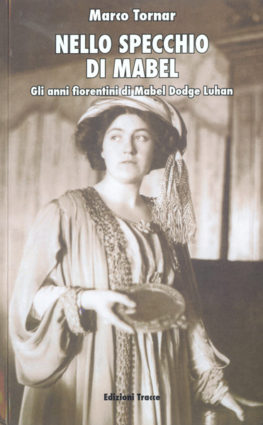
Nello specchio di Mabel, Ed. Tracce, 2011, Pescara-Italy
Curious to know more, I contacted Marco. Our correspondence revealed the book’s evolution. Over time I learned of his impressive background as writer, editor and translator. Part of the avant-garde Jarry Group circle of poets of Pescara in 1978, Marco had already received recognition for his poetry. His published collections include Natural Signs (1983), The Choice (1996), and Sonnets of Sacred Love (2014). Nothing More Than Love, a novel about the elusive power of nature, demonstrated Marco’s facility with prose. He edited The Fury of Pegasus (1996), an anthology of Italian poetry. He translated texts by writers like Nobel prize winner Sigrid Undset and Nobel prize nominee Henry James, who dipped their pens in Italian soil. Undset drew on her experiences in Rome for her biographical novel on St. Catherine of Siena. James’s travel volume Italian Hours provided background for fictional works like The Aspern Papers.
Out of love for English Romantic poets Lord Byron, Percy Bysshe Shelley, and Robert Browning, Marco translated their poetry into Italian. Research led him to Anglo expatriate women writers who had lived in Florence. Wishing to bring them recognition, Marco translated their long-forgotten poems and writing. Names included Kate Field and Constance Grosvenor Alexander, cousin of Mabel’s friend Francesca Alexander.
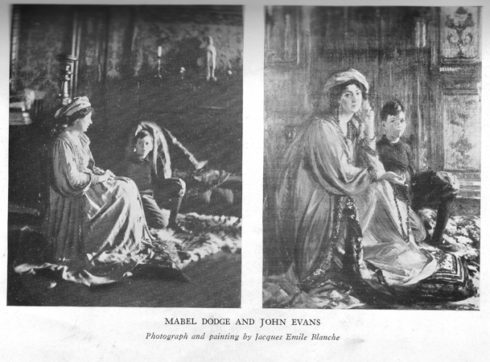
This page from Mabel’s memoir, European Experiences, inspired Marco Tornar
Marco made that connection later. He first discovered Mabel through a book on Robert “Pen” Browning, born in Florence the only child of Robert and Elizabeth. Seeing Jacque-Emil Blanche’s “delicious portrait” of her in European Experiences inspired him. So did Mabel’s writing. He read and translated her European memoir and part of Background and Edge of Taos Desert. Marco also translated Winter in Taos: “a lyrical and emotional testament to her relationship with the desert’s silent beauty.” He considered Mabel’s writing “a pearl of American literature.”
It surprised Marco that none of her work had been translated into Italian. If anyone knew her name, it was only through L’Amica di Lawrence (Lorenzo in Taos), published in 1948. No Italian had written about Mabel. Marco decided he would fill “a sad lack in Italian literature.” After reading every available biography on her – including Lois Rudnick’s two “insuperable” ones – the basis for a biographical novel emerged. Inspired by D. H. Lawrence’s line “for someone who will come”, Marco imagined himself to be that “someone” who arrived a century after Mabel’s time in Florence to feel her presence and capture her memories.
To paint a full picture, Marco arranged to visit the Villa Curonia (now a condominium). He found the structure relatively unchanged.
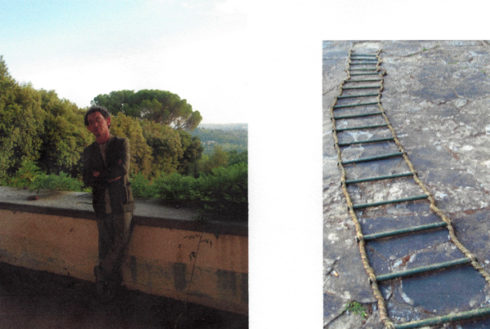
L: Marco Tornar, Villa Curonia; R: Mabel’s silken ladder. Courtesy of Elena Macellari
Fully versed in Mabel’s story, imagine his delight in finding not only the trapdoor leading from Edwin’s bedroom suite down to his wife’s, but also the silken ladder described in European Experiences. Mabel’s words provided the clue:
Overhead in the ceiling there is a square opening large enough for a man to come through. When he opens it, he would find a long silken ladder coiled, hanging on a golden hook. Edwin’s and my whim one day. (Very Renaissance, really.) It was for Edwin to come down on instead of going along the long corridor to the stairs. This silken ladder was also for haste, lover’s haste. But Edwin never hastened down it except once to see if it would work, and it did, perfectly.
Marco’s fascination with expatriate women living in Florence resulted in the novel Claire Clairmont (2010). His portrayal of her illuminated “the absolutely unforgettable personality of a woman marked by the birth of Allegra, daughter of Lord Byron.” Immersion in Clairmont’s 19th-century milieu paved the way for Marco bringing Mabel to life.
In Mabel’s Mirror centers on the Florentine-Anglo upper class during a golden age of literature and arts in Europe. Mabel’s poem “The Mirror” (1914) prompted the title. Reviewing Nello Specchio di Mabel, Italian poet Massimo Pamio likened Marco’s book to theater. In Mabel’s memoirs Marco found scenes, actors, and drama – the stuff novels are made of. Mabel’s furnishings – chaise longues, tapestries, Louis XV furniture, Dresden china, a Sevres figure of black-masked Pierrot – created the atmosphere.
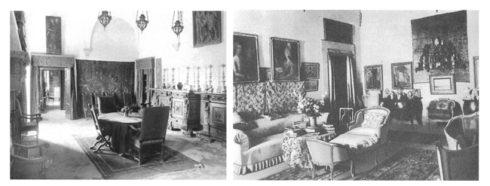
Photos showing Mabel’s furnishings at the Villa Curonia, ca. 1906. L: dining room; R: yellow salon. Mabel Dodge Luhan Papers, Beinecke Rare Book and Manuscript Library, Yale University
Using third-person narrative, Marco wrote dialog based on real-life characters like diva Eleonore Duse, writer Gertrude Stein, and art collector Arthur Acton. Interchanges between this diverse society of writers, artists, historians and art collectors spurred the action. Marco held dramatic tension using a mirror as metaphor. As narrator, he reflected both Mabel’s life and his own. Mirrored through Mabel’s eyes, he felt his own soul expand. Juxtaposing the twentieth century with twenty-first, Marco explored the mystery in “everything that is in man”. Achieving “the flame of his vision” with this novel, he paid tribute to “an extraordinary figure of a woman,” a woman Italians could fall in love with.
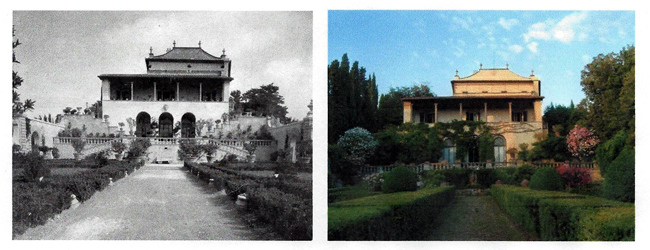
Villa Curonia, ca. 1906. Mabel Dodge Luhan Papers, Beinecke Rare Book and Manuscript Library, Yale University; Villa Curonia, 2005. Courtesy of Elena Macellari
When Marco visited the Villa Curonia, his dear friend Elena Macellari accompanied him. In 2005 agronomist Elena had published Gardeners and Botanical Exhibitions in Italy (1800-1915). She later wrote the introduction to Marco’s translation of British writer Vernon Lee’s 1897 treatise on Ancient Italian Gardens.
The neo-Renaissance garden at Villa Curonia delighted them both. Relatively nothing had changed since Mabel sold the property in 1935. She and her husband Edwin Dodge adhered to the guiding principles of the classic Italian garden. Boxwood hedges enclosed the formal garden with its geometry of neat lines and tracks. Meandering walkways leading off the geometric garden accessed the surrounding “forest parks” of oak and cypress.
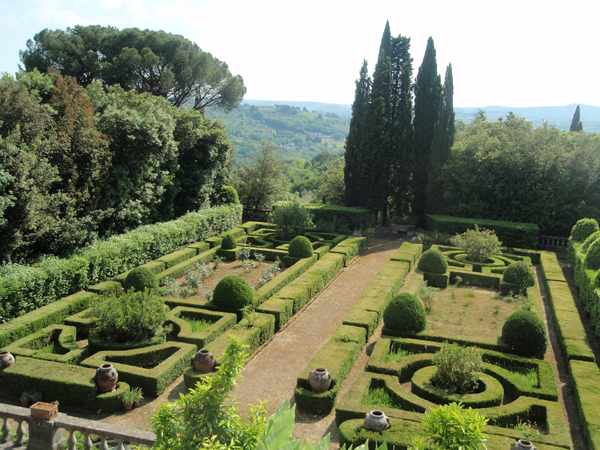
The Garden at Villa Curonia, 2005. Courtesy of Elena Macellari
Mabel’s memoirs provide an overview of the garden’s plantings. Edwin transplanted cypress trees along the outer edge of the drive up to the villa. Mabel planted pink May roses at their feet. In the main garden, iris and yellow, white and pink Dorothy Perkins rose vines added to the “outdoor flowery boudoir”. Oleanders, lilacs, gardenia and jasmine perfumed the air. A daphne grew to one side of the Yellow Salon. A rose pergola created “a wide leafy awning between the house and the ilex [oak] bower at the edge of the outside wall.” Besides ilex and cypress, the outlying forest park included olive trees and stone pines. Satisfied with the entirety of their restoration, Mabel commented: “When it was completed, the villa, resting in its gardens, was at ease.”
Part of the architectural whole, gardens mattered to Mabel. While the giardino received brief mention in Marco’s novel, it warranted special treatment. Elena wrote an afterword in Nello Specchio di Mabel, placing the garden in historical context. She considered it Mabel’s most interesting art work. Further, she ranked Mabel with such cultural luminaries as George Sand and Alma Mahler.
# # # # #
Last September I prepared to write about Mabel’s years in Florence. I needed photos of the Villa Curonia. I remembered illustrations in Marco’s book. After receiving no response from him, I happened upon Elena Macellari’s article on the Villa Curonia featured in the Wall Street International. I remembered her contribution to Nello Specchio di Mabel. I wrote asking her for photo use permission, adding that I hadn’t heard from Marco. She conveyed the news of his sudden death from a heart attack in February 2015. He was one of her best friends.
Elena planned a memorial for Marco at the Villa Bardini in Florence on October 24th. Scholars, writers, musicians, and poets would gather to celebrate his life. In his honor, I wrote a letter of appreciation. A portion appears here:
Our archives at the Mabel Dodge Luhan House are augmented not only through Marco’s book but also through the important information and charming poetic language contained in his emails. He enriched our lives, touched our hearts, and made the world a better place.
Marco once asked me to honor Mabel by placing a red rose on her grave. I carried out his wish on the day of his memorial in Florence. Elena later wrote her own tribute to Marco, published in Wall Street International.
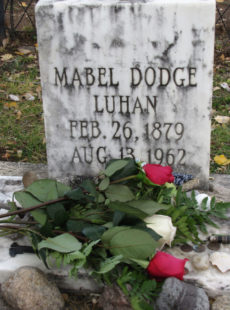
Since then, I’ve had the privilege of corresponding with Elena Macellari. No surprise to find her accomplishments and talents as impressive as Marco’s. She earned her doctorate in Agricultural Regional Planning, including garden and landscape design. After working with the National Research Council in Perugia and Milan, Elena directed an agricultural company specializing in plant biomass, eco-tourism and other green technologies. In her private practice, she offers technical assistance for farms, conducts environmental assessments, and landscaping services. Through musical performances, Elena helped support the Agronomists Without Borders Association’s agricultural projects. She has conducted seminars on the subject of Italian gardens and botanical history. Italian and foreign magazines have published her articles. The Wall Street International alone published essays ranging in subject matter from farro to botanical gardens to women with gardening passions like Edith Wharton and Vernon Lee.
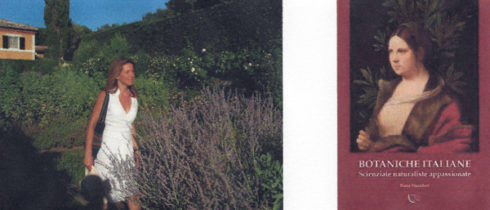
L: Elena Macellari at La Foce Garden (established by Iris Origo), Chianciano Terme (Siena), 2011; R: cover of Botaniche Italiane by Elena Macellari, Temi Edizioni, 2015
The art of the garden and the history of botany remain dear to Elena’s heart. Last year she debuted her new book, Botaniche Italiane: Scienziate Naturaliste Appassionate (Women Botanists of Italy: Scientists and Passionate Naturalists). “With my book, I intended to make a fitting tribute to these pioneers of research.” Like Marco, Elena champions women’s cultural contributions.
00
We at the Mabel Dodge Luhan House express our gratitude to Marco and Elena for keeping the story of Mabel Dodge Luhan alive in Italy.
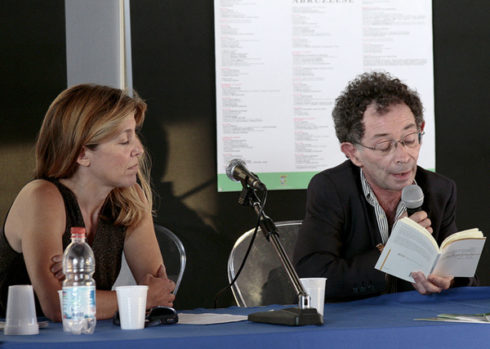
Elena Macellari listens as Marco Tornar reads from her book, Eva Mameli Calvino (leading early 20th-century Italian botanist, mother of Italo Calvino), in Pescara, Italy, 2011. Courtesy of Elena Macellari